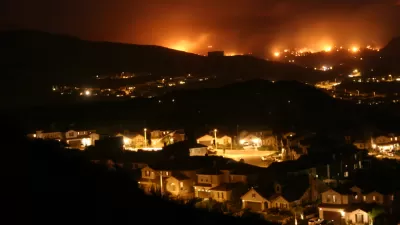Regions at high risk for flooding, wildfires, and other climate-fueled disasters continue to see rapid population growth.

Americans are moving to regions at high risk of climate-related disasters, putting more people in the path of dangerous hurricanes, wildfires, and other climate crises, reports Aimee Picchi for CBS News.
This is despite spiking insurance costs — and the refusal of some insurers to cover homeowners in certain states, such as Florida and California, altogether. A 2023 report found that over 3 million Americans have moved to new areas due to growing flood risks and prohibitively high insurance rates. “The average annual premium for a Florida homeowner is $5,500 — about 140% higher than the typical U.S. homeowner's cost of $2,285, according to Bankrate.”
However, “The populations of high-risk counties have grown at a rate that's 3 percentage points faster than low-risk counties over the last three decades, according to research from economists Agustin Indaco, Francesc Ortega and Xinle Pang.” In the West, where wildfires are growing larger and more destructive, is also seeing outsized population growth as people newly untethered from office jobs seek more affordable housing options.
According to a recent study, the bulk of migration, as well as development in flood-prone areas, is mainly concentrated in Florida and Louisiana, as well as other parts of the Gulf Coast.
FULL STORY: Americans are flocking to U.S. regions most threatened by climate change

Maui's Vacation Rental Debate Turns Ugly
Verbal attacks, misinformation campaigns and fistfights plague a high-stakes debate to convert thousands of vacation rentals into long-term housing.

Planetizen Federal Action Tracker
A weekly monitor of how Trump’s orders and actions are impacting planners and planning in America.

In Urban Planning, AI Prompting Could be the New Design Thinking
Creativity has long been key to great urban design. What if we see AI as our new creative partner?

King County Supportive Housing Program Offers Hope for Unhoused Residents
The county is taking a ‘Housing First’ approach that prioritizes getting people into housing, then offering wraparound supportive services.

Researchers Use AI to Get Clearer Picture of US Housing
Analysts are using artificial intelligence to supercharge their research by allowing them to comb through data faster. Though these AI tools can be error prone, they save time and housing researchers are optimistic about the future.

Making Shared Micromobility More Inclusive
Cities and shared mobility system operators can do more to include people with disabilities in planning and operations, per a new report.
Urban Design for Planners 1: Software Tools
This six-course series explores essential urban design concepts using open source software and equips planners with the tools they need to participate fully in the urban design process.
Planning for Universal Design
Learn the tools for implementing Universal Design in planning regulations.
planning NEXT
Appalachian Highlands Housing Partners
Mpact (founded as Rail~Volution)
City of Camden Redevelopment Agency
City of Astoria
City of Portland
City of Laramie





























